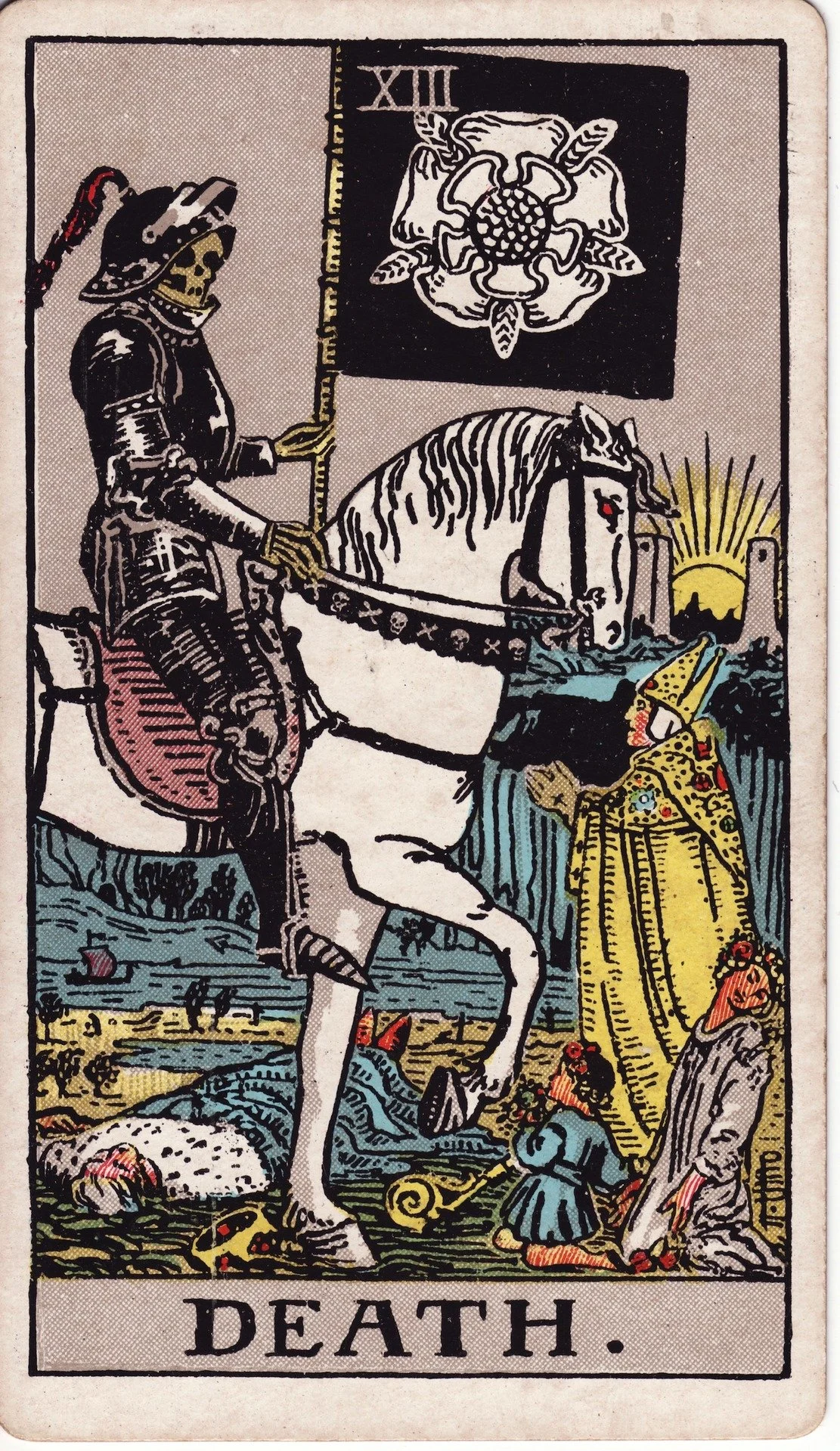What does Death mean in tarot?
Death represents transformation, endings that lead to new beginnings, and the natural cycles of release and renewal. In the Rider-Waite deck, a skeleton in black armor rides a white horse, carrying a black banner with a white rose, while a sun rises between two towers in the distance. At a glance, Death upright indicates that profound change is inevitable: old patterns, relationships, or life phases are ending to make way for something completely new and more aligned with your spiritual growth.
The white horse symbolizes purity of purpose in this transformation, while the black armor represents the mystery surrounding change. The white rose on the banner indicates that beauty and new life emerge from apparent endings, and the rising sun promises renewal after darkness. Like The Tower, Death brings necessary change, but unlike The Tower's sudden upheaval, Death's transformation is more natural and inevitable.
What does Death mean reversed?
When Death appears reversed, it suggests resistance to necessary change, stagnation, or fear of letting go of what no longer serves you. This reversal often indicates that you're clinging to situations, relationships, or ways of being that have already run their course, preventing the natural flow of growth and renewal.
The reversed Death can point to incomplete transformations, where you've begun changing but stopped halfway through the process. It might suggest avoiding grief work, refusing to accept endings, or being stuck in transitions without fully committing to what comes next.
Sometimes this reversal indicates that transformation is happening more slowly than expected, requiring patience with the process. Unlike The Hanged Man's willing suspension, reversed Death often involves unwilling resistance that prolongs difficulty.
Is Death a yes or a no?
Death is ultimately a "yes," but not in the way you might expect, this card indicates that profound transformation is necessary for your true desires to manifest. Your original goal may need to "die" completely to make room for something far better, or you may need to release old versions of yourself to achieve what you're seeking. The answer is positive for questions about major life changes, ending unhealthy situations, or allowing natural cycles to complete, but it warns that the path forward requires letting go of what no longer serves you.
Death reminds you that sometimes the most powerful "yes" comes through embracing endings, trusting that what emerges from the ashes will be more aligned with your authentic purpose. Like the renewal promised in The Star after a dark night of the soul, Death's transformation leads to rebirth and hope, but only after you courageously release what must be left behind.
What does Death mean for love?
In romantic matters, Death represents the end of relationship phases, profound transformation in partnerships, or the completion of romantic cycles that have served their purpose. This card doesn't typically predict literal breakups but rather deep changes that allow relationships to evolve into something entirely new and more authentic.
For those seeking love, Death encourages releasing old patterns, healing from past relationships completely, and allowing your romantic life to transform rather than repeating familiar but unfulfilling cycles. Like The Hermit's period of solitude, Death's ending phase prepares you for more meaningful connections.
In existing relationships, Death indicates major transitions: moving in together, marriage, having children, or working through significant challenges that either strengthen the bond or reveal fundamental incompatibilities. It suggests that your relationship cannot continue as it has been and must evolve to survive.
When reversed in love, Death warns against staying in relationships that have clearly ended or avoiding necessary conversations about your relationship's future. It can indicate fear of being alone that prevents healthy endings or resistance to relationship growth that keeps partnerships stuck in outdated patterns.
FAQs about Death
What does Death mean for the future?
Death in future positions indicates that significant life changes await that will completely transform your circumstances, identity, or understanding of yourself. This placement suggests your future holds profound transitions that, while initially challenging, will ultimately align you with your authentic path and higher purpose. You may find yourself releasing career paths, relationships, or belief systems that no longer fit who you're becoming. The future represented by Death promises rebirth and renewal, but requires courage to let go of familiar foundations.
Is Death a good card?
Death is ultimately very positive, representing necessary transformation, spiritual evolution, and the courage to embrace life's natural cycles of death and rebirth. While it can indicate difficult endings or periods of grief, its core message celebrates the beauty of transformation and the endless possibility for renewal. Death reminds us that clinging to what's finished prevents us from receiving what's meant to come next. Like The Fool's leap into the unknown, Death asks us to trust that endings always contain the seeds of new beginnings.
What does Death mean spiritually?
Spiritually, Death represents the ego's dissolution and the soul's continuous evolution through countless transformations. This card suggests you're experiencing a profound spiritual death and rebirth, where old identities, beliefs, or ways of understanding yourself are dying to make room for greater truth and authentic expression. Death embodies the mystical teaching that we must die to our smaller selves to be reborn into our larger purpose. It indicates that you're learning to see endings as sacred transitions rather than losses, understanding that consciousness itself is eternal even as forms change.
Where The Hanged Man taught surrender and new perspective through suspension, Death shows how that surrender naturally leads to complete transformation and spiritual rebirth.
Ready to explore what emerges from this sacred transformation?
Learn about Temperance and discover how Death's profound changes lead to the wisdom of balance, patience, and the integration of all experiences into harmonious wholeness.

